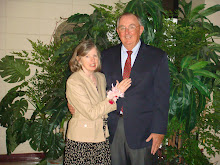Obviously this area of Israel will be of great interest as it is where Jesus spent most of his life. We will visit Nazareth, Capernaum and surrounding areas. Should be quite exciting.
Let me give you an idea of a typical day when we are on these all day trips.
We board a bus at 7 AM. It is a nice tour bus - comfortable and air conditioned. We then ride to our first site - generally an archeological dig of an ancient city or area. Most of these cities are located on high hills or mounds. We hike up the hill and listen to a series of lectures at several locations lasting between 30 and 45 minutes. We walk around the site and take pictures and then return to the bus and head for the next site.
We will repeat this pattern five or six times during the day. Lunch is prepared and served about noon. It consists of a pita stuffed with either tuna salad or turkey and cheese slices. We have fresh carrots, olives, pickles and an assortment of peanut butter and jellies for dessert. All of this is packed in coolers brought with us.
We usually end the day about 6 PM, have dinner and explore around the place we are staying.
Water is essential. In a typical day I will drink about five liters of water. That's ten of the water bottles we buy at the grocery store. At least one person has gotten dehydrated by not consuming enough water.
I am guessing that in a typical day we will walk five to six miles. And in Israel every step is either uphill or downhill and in the field it is generally on rocks. Carefulness in stepping is essential for this old guy. (By the way, thanks Judy for the "Old geezer at Gezer" comment!)
Speaking of rocks - I have never seen so many rocks or so many stone structures.To use a big word they are ubiquitous.
Internet service will not be available where we are going. Thus, I will not post any blogs or pictures until next week.
I appreciate the words of encouragement from those who read the blog and look forward to sharing more in the days ahead.
The Lord bless you and keep you; the Lord make his face to shine upon you and be gracious unto you; the Lord lift up his countenance upon you and give you peace.
Until later.

















